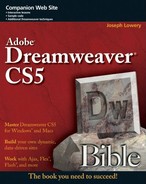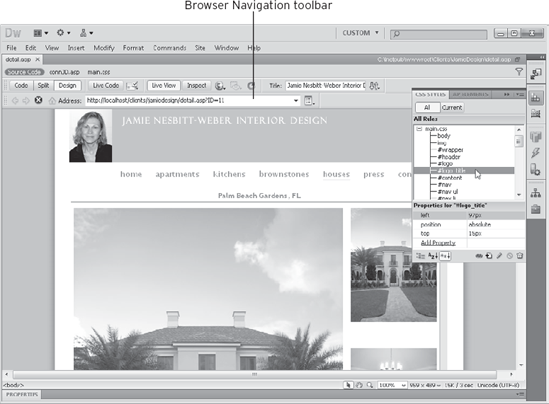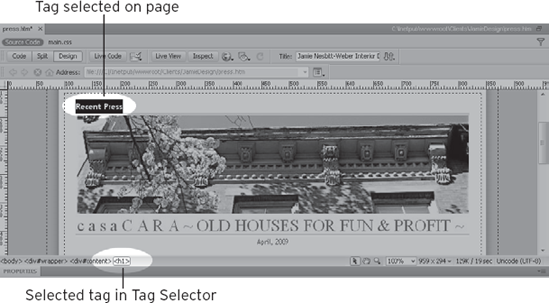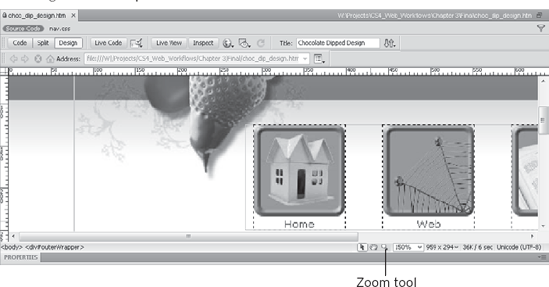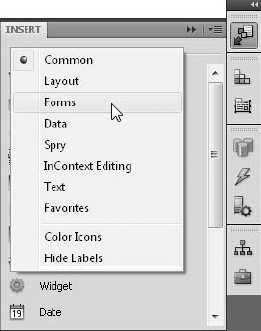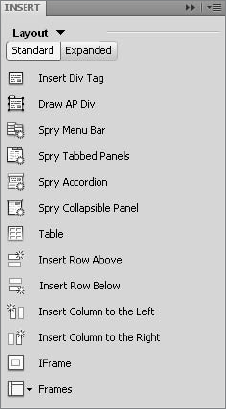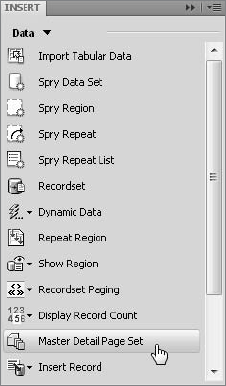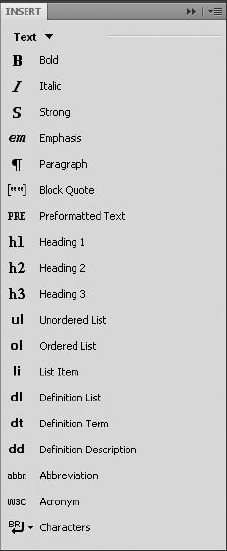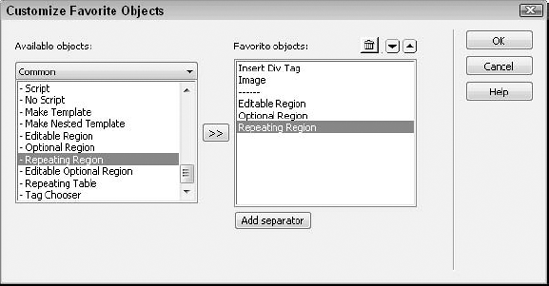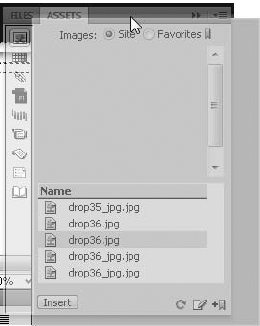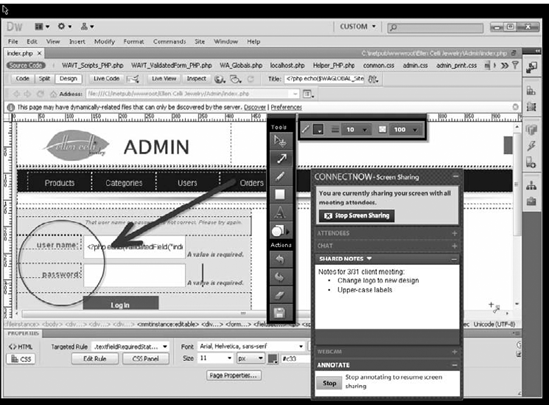Dreamweaver's user interface is efficient, powerful, and flexible. By offering a wide variety of customizable tools and controls, Dreamweaver helps you tailor its workspace to your specific preferences and needs so that you can focus on the task of creating your Web site. This chapter provides a detailed overview of the Dreamweaver workspace so you know where all the tools are when you need to use them.
One of Dreamweaver's greatest strengths is its flexibility. The makers of Dreamweaver realize that not everyone works in the same way, and they have created a product that you can customize to maximize your efficiency. By default, Dreamweaver provides a range of different workspace layouts and even allows you to customize your own.
You can access these options by choosing Window
The default layout option is referred to as the Designer workspace. Here, the most design-oriented of Dreamweaver's many panels are organized into groups and docked on the right side of the window, with the panel names exposed. The Designer workspace is illustrated in Figure 2-1.
A variation on the Designer workspace is the Coder workspace option. Here, the panels are docked on the left side of the window rather than the right. With this option, when you first open documents, you are presented with the code for the document, rather than a view that reflects what the page will look like when viewed in a browser. Figure 2-2 shows the Coder workspace layout.
Note
You have numerous options for customizing Dreamweaver. Later in this chapter, you learn how to move the panels and toolbars; dock or float the panels; hide, show, or resize panels; and more. Chapter 3 systematically covers many additional customization options, referred to within Dreamweaver, as with most programs, as preferences.
Another option, Dual Screen, is useful if you have two monitors for the same computer. When invoked, the Dual Screen layout undocks all the major components (Property inspector, panel groups, and Code inspector) so that they can be positioned exactly how you like.
Other layout options are detailed in Table 2-1.
Table 2-1. Default Layout Options
Layout | Panels on Left | Panels on Right | Property Inspector | View |
|---|---|---|---|---|
App Developer | CSS Styles, AP Elements Databases, Bindings, Server Behaviors Files, Assets, Snippets [Labels without icons] | No | Split | |
App Developer Plus | CSS Styles, AP Elements Files, Assets, Snippets [Labels without icons] | Insert Databases, Bindings, Server Behaviors [Labels with icons] | Yes | Split |
Classic Insert panel presented as Insert bar along top of Document window as with Dreamweaver CS3 | CSS Styles, AP Elements, Tag Inspector Databases, Bindings, Server Behaviors Files, Assets, Snippets [Labels without icons] | Yes | Design | |
Coder | CSS Styles, AP Elements Files, Assets, Snippets [Labels without icons] | No | Code | |
Coder Plus | Files, Assets, Snippets [Labels without icons] | Insert CSS Styles, AP Elements [Labels with icons] | No | Code |
Insert CSS Styles, AP Elements Business CatalystFiles, Assets [Labels without icons] | Yes | Design | ||
Designer Compact | Insert CSS Styles, AP Elements Business CatalystFiles, Assets [Labels with icons] | Yes | Split | |
Dual Screen | Insert CSS Styles, AP Elements Business Catalyst Databases, Bindings, Server Behaviors Assets, Snippets [Grouped together but undocked, labels without icons] Files [Undocked panel] | Code inspector [Undocked panel] | Yes | Split |
If you ever adjust a standard layout and want to return to its default settings, choose Reset Workspace, where Workspace is the name of the workspace from either the Window
All customized layouts can be saved for later retrieval. Once you've set up the desired layout, you can choose Window
Tip
If you aren't sure which workspace works best for you, don't worry; you can switch workspaces at any time and even completely customize a workspace so that it works the way you do.
The default workspace for Mac users, shown in Figure 2-3, is a variation of the Windows version. In this workspace, the first new document opens in a separate Document window, and the tools are grouped into floating panels that can be docked to each other. When you open subsequent pages, they open in tabs that you can switch between. The Dreamweaver menus appear on the standard menu bar, and change as you switch Mac applications, rather than appearing on the Application bar. Another difference from the Windows layout is that you can see, and access, your Mac's Desktop behind the Document window instead of seeing the usual gray background of Windows applications. Unlike other applications in CS5, Dreamweaver doesn't offer Mac users the capability to enable the Application Frame, a boxed-in version of the application that blocks the view through to the Desktop with a Windows-like gray background.
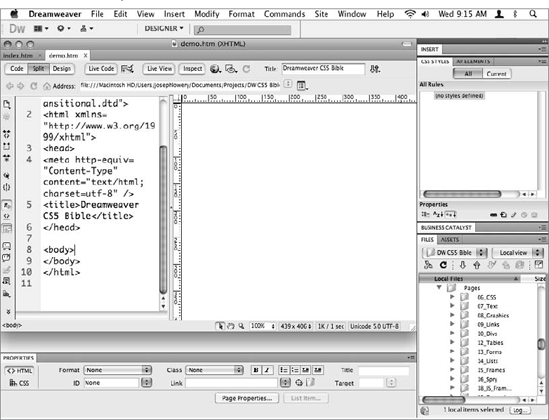
Figure 2-3. The default workspace for Mac enables users to position panels wherever they would like while still being able to see the Desktop.
As you can see in Figures 3-1, 3-2, and Figure 3-3, all the workspaces comprise variations of the same basic elements even though they are laid out differently on the screen. For the most part, you work with those elements in the same way, regardless of workspace; the only major differences among the workspaces are the location of the tools onscreen and which panels are open. The basic elements of Dreamweaver include the following:
Document window
Toolbars
Insert panel
Property inspector
Panels
Menus
The rest of this chapter takes you on a tour of each of these basic interface elements.
Dreamweaver's primary work area is the Document window. When you first create a new page in Dreamweaver, you see what is essentially an empty canvas surrounded by tool panels and toolbars. This canvas is where you create your Web pages by typing headlines and paragraphs; inserting images and links; and creating tables, forms, and other HTML elements.
You can open more than one document at once in Dreamweaver, and all of your documents are viewed within the same window. If the documents are not maximized, you can see more than one document at once using the various window manipulation commands on the Window menu. If you want to separate documents, choose Window
If you maximize one document, all the open documents are maximized. Switch between the open documents by clicking the appropriate tab for the document, located near the top of the window. The buttons to minimize, restore, and close a maximized document on Windows are located in the upper-right corner of the Dreamweaver Document window. On a Mac, the buttons to close, minimize, and restore a group of tabbed documents remain in the upper left of the document window. To close one document, click the close widget to the right of the filename on each tab. You can also right-click a document tab and choose Close from the context menu to close the document. Figure 2-4 illustrates maximized documents within the Windows workspace.
Tip
To change the order in which your documents are displayed in tabs, drag a tab to the desired position.
If you open more documents than it can show, Dreamweaver displays Next and Previous arrows that enable you to scroll through the tabs.

Figure 2-4. In the Dreamweaver workspace on Windows, use tabs to switch between maximized documents.
Typical Web design tasks consist of visually creating a page in Dreamweaver, perhaps tweaking the underlying code to achieve the exact effect you want, and making sure your standard Web page or application is performing as expected. You can do all these things without ever leaving the Dreamweaver Document window, simply by switching the view of the page you are editing.
In Design view, you lay out a page visually. As your Web page begins to take shape, Design view shows you a close representation of how the page looks when viewed through a browser such as Firefox or Internet Explorer. You can even see active elements, such as QuickTime movies or Shockwave and Flash files in your Web page as you're building it. You can switch to Design view with the View
As the name suggests, Code view displays the underlying code used to create the document, whether that is HTML, CSS style definitions, or JavaScript — whatever code is used to create the page is visible to you in Code view. If you are working in the Coder style workspace, Code view is the default view; but you can also switch to Code view by choosing the View
You can choose View
When you switch document views, the switch applies to the currently active open document and to any subsequent documents you open. It does not, however, change the view of other open documents.
Whereas Design view gives you an editable, browser-approximate display of your Web page, Live View is an actual real-world browser rendering. Although Live View is not editable, it is tightly integrated with Code view, so that any changes made to the code are immediately rendered when you refresh the page.
Live View is based on Apple's open source browser engine, Webkit, which is the basis for Apple's Safari and Google's Chrome browsers. Live View brings a whole new workflow to Dreamweaver, one that is well-suited to the modern Web designer's task of crafting complex Web pages that integrate external JavaScript, CSS, or server-side include files. Live View not only displays Web pages accurately according to up-to-date Web standards, it also provides basic interactivity so you can test your CSS or JavaScript rollovers right within Dreamweaver.
Live View is best used in conjunction with Code view. The typical workflow is to switch to Live View once your basic page has been completed and you are fine-tuning the code. At this stage, click Live View in the Document toolbar or choose View

Figure 2-5. Quickly edit your document in two different modes — code or WYSIWYG design — with Split view.
When you enter into Live View, the Live Code feature becomes available. Like Live View, Live Code gives you a real-world, albeit uneditable, window into your Web page, but on the code side. You can easily tell you're in Live Code by yellow highlighted code. Certain JavaScript or server-side functions may rewrite the HTML sent to the browser to be rendered. With Live Code enabled, you can see the exact code used. Moreover, you can interact with the page in Live View and then stop the interactivity by choosing View
Note
Enhanced features such as Related files and the Code Navigator, as well as the capability to freeze JavaScript, are all part of the Live View and Live Code workflow. To learn more about how to use Live View with these features, see Chapter 5.
If you are creating a Web application that includes dynamic elements from a database, Live View can also serve you well. When you invoke Live View while the current page uses the PHP, ASP, or ColdFusion server model, Dreamweaver displays your page with data from your data source. The live data that Dreamweaver displays replaces data source placeholders such as {rs.employeeID} with the selected information pulled from the database's designated field, as shown in Figure 2-7.
To use Live View with a dynamic page, you'll need a connection to a testing server, either local or remote, to be properly established in the Site Definition dialog box. If Dreamweaver is unable to complete the connection, an error message appears with several possible solutions listed.
Note
Live View is extremely helpful in building your Web applications. Find out more about how to use this important feature in Chapter 21.
The status bar is found at the bottom of the Document window. Embedded here are several important tools: the Tag Selector, Zoom tool, Window Size pop-up menu, and Download Indicator. These helpful status bar tools provide the Web designer with several timesaving utilities.
The Tag Selector is an excellent example of Dreamweaver's elegant design approach. On the left side of the status bar, you see a listing of the current HTML tags. When you first open a blank page in Dreamweaver, you see only the <body> tag. If you type a line of text and then press Enter (Return), the paragraph tag <p> appears. Your cursor's position in the document determines which tags are displayed in the Tag Selector. The Tag Selector keeps continuous track of where you are in the HTML document by displaying the tags surrounding your current cursor position. This becomes especially important when you are building complex Web pages that use such features as nested tables.
As its name implies, the Tag Selector does more than just indicate a position in a document. Using the Tag Selector, you can quickly choose any of the elements surrounding your current cursor. After an element is selected, you can modify or delete it. If you have the Property inspector (described later in this chapter) onscreen, choosing a different code from the Tag Selector makes the corresponding options available in the Property inspector.
Tip
If you want to quickly clear most of your HTML page, choose the <body> tag in the Tag Selector and press Delete. All graphics, text, and other elements you have inserted through the Document window are erased. Left intact is any HTML code in the <head> section, including your title, <meta> tags, and any preliminary JavaScript. The <body> tag is also left intact.
In a more complex Web page section, such as the one shown in Figure 2-8, the Tag Selector shows a wider variety of HTML tags. As you move your pointer over individual codes in the Tag Selector, they are highlighted; click one, and the code becomes bold. Tags are displayed from left to right in the Tag Selector — starting on the far left with the most inclusive (in this case, the <body> tag) and proceeding to the narrowest selection (here, the italic <h1> tag) on the far right.
As a Web page developer, you're constantly selecting elements in order to modify them. Rather than rely on the click-and-drag method to highlight an area — which often grabs unwanted sections of your code, such as <td> tags — use the Tag Selector to unerringly pick just the code you want. Dreamweaver's Tag Selector is a subtle but extremely useful tool that can speed up your work significantly.
Right-clicking (Control+clicking) an item in the Tag Selector displays a menu that contains several tag-editing commands. Using this menu in Design view, you can remove the tag or select a class or id attribute for the tag. From either Design view or Code view, you can also modify the tag by choosing Edit Tag from the context menu.
With the greater layout flexibility made possible by CSS positioning comes the need for more powerful design tools. The first set of tools on the right side of the status bar offer Dreamweaver designers a number of options for viewing and interacting with the page at design time.
With the new Zoom enhancement, Dreamweaver joins the ranks of other page layout programs by offering designers the ability to magnify a page for finer design control. This set of tools — Select, Hand, Zoom, and the Set Magnification pop-up menu — work together. In the typical design session, Dreamweaver is generally in Select mode, which allows the selection and manipulation of any and all page elements. Choose the Hand tool to pan around a page that is larger than the Document window, whether or not the page is magnified.
The Zoom tool works in a multifaceted fashion similar to graphic applications such as Photoshop and Fireworks. Once you've selected the Zoom tool, you can:
Magnify a specific section of the page by clicking that area; each click increasing the magnification according to the values in the Set Magnification pop-up menu. For example, one click magnifies the area from 100 to 150 percent and then another goes to 200 percent magnification and so on. Hold Alt (Option) while clicking to zoom out of an area.
Drag a rectangle around the area to magnify to view that section at the highest magnification, as shown in Figure 2-9.
To zoom in or out by a preset amount, select a value from the Set Magnification pop-up menu. Magnification options range from 6 to 6400 percent. You can also opt to zoom in on a specific selection by choosing Fit Selection, the width of the page by choosing Fit Width, or view the entire page by choosing Fit All. If you prefer to view the page at a specific magnification not found on the Set Magnification pop-up menu, you can enter the value directly in the field and press Tab; there's no need to enter the percent symbol, %.
Tip
If you're zoomed in or out of a page, you can double-click either the Zoom or Pointer tool to return to 100 percent magnification. To quickly begin selecting in standard magnification, double-click the Pointer tool.
Keyboard shortcuts are also available for zooming in and out of the page. Press Ctrl+= (Command+=) to zoom in and Ctrl+− (Command+−) to zoom out.
To return to editing the page — at any magnification level — click the Select tool.
The universality of the Internet enables virtually any type of computer system from anywhere in the world to access publicly available Web pages. Although this accessibility is a boon to global communication, it forces Web designers to be aware of how their creations look under various circumstances — especially different screen sizes.
The Window Size pop-up menu gives designers a sense of how their pages look on different monitors. Located just right of center on the status bar, the Window Size pop-up menu indicates the screen size of the current Document window, in pixels, in width × height format. If you resize your Document window, the Window Size indicator updates instantly. This indicator gives you an immediate check on the dimensions of the current page.
The Window Size pop-up menu goes beyond just telling you the size of your screen, however — it also enables you to quickly view your page through a wide variety of monitor sizes. Naturally, your monitor must be capable of displaying the larger screen dimensions in order for you to select them.
To select a different screen size, click once on the expander arrow to the right of the displayed dimensions to bring up a menu listing the standard sizes, as shown in Figure 2-10. Click a size from the menu.
Note
If no sizes are listed in the status bar, you may be in Code view, described later in this chapter. Select View
The standard sizes, and their most common uses, are as follows:

Figure 2-10. You can change your current screen size to any of six standard sizes — or add your own custom sizes — with the Window Size pop-up menu.
The first option, 592w, is the only option that does not change the height as well as the width. Instead, this option uses the current window height and alters only the width.
Tip
You can set up your own custom screen settings by choosing Edit Sizes from the Window Size pop-up menu. This option opens the Status Bar category of the Preferences dialog box. Chapter 3 describes how to modify the pop-up list.
The dimensions offered by the Window Size pop-up menu describe the entire editable area of a page. The Document window has been carefully designed to match specifications set by the primary browsers. Both the left and right margins are the same width as both the Netscape and Microsoft browsers, and the status bar matches the height of the browser's bottom row as well. The height of any given browser environment depends on which toolbars are being used; however, Dreamweaver's menu bar is the same height as the browsers' menu bars.
So, you've built your Web masterpiece, and you've just finished uploading the HTML, along with the 23 JPEGs, 8 audio files, and 3 Flash movies that make up the page. You open the page over the Internet and — surprise! — it takes five minutes to download. Okay, this example is a tad extreme, but every Web developer knows that opening a page from your hard drive and opening a page over the Internet are two vastly different experiences. Dreamweaver has taken the guesswork out of loading a page from the Web by providing the Download Indicator.
The Download Indicator is located to the right of the Window Size item on the status bar. As illustrated in Figure 2-11, Dreamweaver gives you two values, separated by a slash character:
The cumulative size of the page, including all the associated graphics, plugins, and multimedia files, measured in kilobytes (KB)
The time it takes to download at a particular modem connection speed, measured in seconds (sec)
Tip
You can check the download size of any individual graphic by selecting it and looking at the Property inspector — you can find the file size in kilobytes next to the thumbnail image on the left.
The Download Indicator is a handy real-world check. As you build your Web pages, it's a good practice to monitor your file's download size — both in kilobytes and seconds. As a Web designer, you ultimately have to decide what your audience will deem is worth the wait and what will have them reaching for that Stop button. For example, the graphic shown in Figure 2-12 is attractive and, at less than 10KB, it helps keep the entire page at an acceptable 60KB. Remember that all the component parts of a page make up the total file weight shown in the Download Indicator.
Note
Not everybody has the same modem connection. If you are working with an intranet or on a broadband site, you can set your connection speed far higher. Likewise, if your site gets a lot of traffic, you can lower the connection speed. Change the anticipated download speed through Dreamweaver's Preferences dialog box, as explained in Chapter 3.
Regardless of the job — whether it's hanging a picture or fixing a faucet — work goes faster when your tools are at your fingertips. The same principle holds true for Web site building: The easier it is to accomplish the most frequently required tasks, the more productive you'll be as a Web designer. Dreamweaver puts a number of repetitive tasks, such as previewing your page in a browser, just a function key away. However, there are far more necessary operations than there are function keys. In an effort to put needed functionality right up front, Dreamweaver incorporates four toolbars — Standard, Document, Browser Navigation and Style Rendering — located across the top of the Document window. One other toolbar is available only when you are in Live Data view and another when you're in Code or Split view. In addition, Dreamweaver has two other bars built into the interface that provide essential functionality: the Application and Related Files bar.
The Application bar, so-called because of the identifying application icon on the left side, is common to all Adobe Creative Suite software programs. In addition to the menus, you can also find the following user interface elements in the Application bar, shown in Figure 2-13.

Figure 2-13. The goal of the Application bar is to surface commonly used features such as creating a new site or searching help.
Layout: The Layout menu button gives you quick access to the various document views including Code, Split Code, Design, and Code and Design (a.k.a. Split view); you can also toggle the Split Vertically and Design view on Left/Top options from the Layout menu button.
Extend Dreamweaver: Dreamweaver is wonderfully extensible and you can add many time-saving abilities through the free and commercial extensions available. Under the Extend Dreamweaver menu button you'll find quick access to the Extension Manager, the Creative Suites tool for inserting and managing extensions. Two other menu items give you direct access to some of the available extensions. Browse for Web Widgets opens your primary browser to the Adobe Exchange page dedicated to JavaScript Web Widgets compatible with Dreamweaver, and Browse for Other Dreamweaver Extensions takes you to the main Adobe Exchange page for Dreamweaver.
Site: The Site menu button offers two options. New Site opens the Site Definition dialog box so you can define a new local and/or remote site. Manage Sites displays the full-featured Manage Sites dialog box, which allows you to edit, duplicate, or remove existing sites; import or export site settings; or set up new sites or direct server connections.
Workspace switcher: As described earlier in this chapter, the Workspace switcher is used to modify your Dreamweaver environment. You can either choose from default workspaces or create your own custom ones.
Search: The search field included in the Application bar allows you to perform online searches of the Dreamweaver Help system. Enter a term and then press Enter (Return) or click the magnifying glass icon to load the search results in your primary browser.
The Related Files bar is located between the filename tab and the Document toolbar, if the current file contains links to any external CSS, JavaScript, or server-side file. Any such documents, or related files, are listed in the order they are included in the primary Web page, after a Source Code link, which, when clicked, displays the primary Web page in Code view.
The beauty of the Related Files feature is that you can click the entry for a related file to open it in Code view while continuing to display the complete Web page in Design or Live Data view. Any updates made to the code — whether in CSS, JavaScript, or server-side code includes — can be immediately displayed in Live View. If you're not already in Split view, choosing one of the related files will switch to that mode.
Warning
Some Web pages can include a great number of related files — often too many to deal with practically. Dreamweaver provides a filtering mechanism to show just the files you want to work with, whether they're CSS, PHP, or JavaScript. Just click the Filter icon found on the far right of the Related Files bar and toggle on just the file types you need. You can even create a custom filter to restrict the related files displayed to a common file name or extension.
Should you prefer to open related files as separate documents rather than in Code view all the time, there is an option for doing so in the General category of Preferences. To open a related file just once, right-click (Control+click) the related file link and choose Open as Separate File.
Note
To make the most out of the Related Files feature and its companion features (Live Data view and Code Navigator), see Chapter 5.
The Document toolbar gives you quick access to commands that affect the entire document. Like the Standard toolbar, you can hide and show the Document toolbar with a menu command: View

Figure 2-14. The Document toolbar offers easy access to an important element of a Web page, the title.
The first set of buttons in the Document toolbar is dedicated to the various views: Code, Code and Design (also called Split view), and Design. These buttons are mutually exclusive because only one view can be shown at a time. To the right of the first three buttons are two more view-related buttons: Live Code and Live View. As previously explained, when Live View is selected, Dreamweaver renders the page with the built-in browser. Choose Live Code to reveal the code as processed by the browser.
Note
In between Live Code and Live View is the Check Browser Compatibility button, covered in the next section.
Adjacent to Live View is the Inspect button. Click Inspect to display color-coded backgrounds for the margins (yellow), padding (purple), border (green), and content (blue) areas of any element you hover over while in Live View. If you're not in Live View when you click Inspect, Dreamweaver automatically shifts into that mode.
With the wide range of browsers on the market today — many with different rendering capabilities — Web designers need to keep a close eye on their page from start to finish. Dreamweaver offers a handy debugging feature known as Check Browser Compatibility. As mentioned earlier, the Check Browser Compatibility button is found between the Live Code and Live View buttons.
Check Browser Compatibility relies on the Web-building community for its expertise. With the Check Browser Compatibility feature, Dreamweaver currently inspects the page for 26 different CSS issues that affect a full range of modern browsers. In addition to pinpointing the problematic code on your page and describing the error in the Results panel, the Check Browser Compatibility feature also provides a link to the relevant page on Adobe's CSS Advisor site.
Note
For details on each of the CSS rendering issues checked by Dreamweaver, see Chapter 30.
Dreamweaver checks the page against whichever browsers you specify in the Target Browsers dialog box, opened by choosing Settings from the Browser Check menu. You have the option of choosing any or all of six different browsers and specifying the minimum acceptable browser version.
The Check Browser Compatibility menu offers these options:
Check Browser Compatibility: Checks the current page against the browser versions selected in the Settings dialog box.
Next Issue: Displays the first (or next) problem Dreamweaver found in Split view with the cause of the error marked with a wavy red underline. Mouse over the error to see an explanation of the error in a tooltip; Dreamweaver also lists the browser or browsers in which the error occurs.
Previous Issue: Displays the prior error, again marked with a red wavy underline.
Show All Issues: Opens the Target Browser Check category of the Results panel with a list of all the problems found in the document. Double-click an entry to highlight that error in Split view.
Edit Ignored Issue List: Opens the
Exceptions.xmlfile, which contains the browser check errors you want Dreamweaver to ignore during the checking process.Check Accessibility: Runs the Accessibility report for the current file; any errors are displayed in the Results panel.
Check CSS Advisor Website for New Issues: Opens the CSS Advisor site on
Adobe.comin your primary browser.Report a Browser Rendering Issue: Displays the page on the CSS Advisor site to submit a new post; you'll need to be registered with
Adobe.comand signed in to file a new report.Settings: Opens the Target Browsers dialog box where you specify which browser and browser version you want Dreamweaver to check.
I find it helpful to run the Browser Compatibility Check after each major CSS addition (layout, text styling, and so on) during the design stage rather than wait until the page is fully completed. By keeping a close eye on browser compatibility, I keep the debugging compartmentalized and easier to solve.
Although Dreamweaver gives you a good representation of what your page looks like when rendered in a browser, it's not perfect — even with Live View. So many variations exist among the different browser programs — not to mention versions — that you absolutely must test your page throughout the development process.
Selecting the Preview in Browser button on the Document toolbar (next to Inspect) presents a dynamic list of available browsers. All the browsers entered in Preferences appear first, with the primary and secondary browsers leading the list.
The final entry under the toolbar's Preview/Debug in Browser button is Edit Browser List. When invoked, this command opens the Preview in Browser category of Preferences, enabling you to add, remove, or otherwise manage the browsers on your system in relation to Dreamweaver.
Note
See Chapter 3 for details about working with the Preview in Browser preferences.
The next two items on the Document toolbar are the Visual Aids and the Refresh Design View buttons. Use the Refresh Design View button when you've altered code directly in the Code view and you're ready to apply those changes in the Design view; this option is especially useful when the split-screen Code and Design view is in operation.
The layout-oriented Visual Aids are only available in Design view. A series of options toggle Web page–focused helper tools on and off. One command, Show/Hide All Visual Aids, displays or conceals all of them at once. The Visual Aids are:
Hide All Visual Aids
CSS Layout Backgrounds
CSS Layout Box Model
CSS Layout Outlines
AP Element Outlines
Table Widths
Table Borders
Frame Borders
Image Maps
Invisible Elements
At the far right end of the Document toolbar is the Title text field for displaying and altering the title of your document. Dreamweaver, by default, titles every new page Untitled Document. Not only is it considered bad form to keep this default title, search engines need a relevant title to properly index a site. To change a page title, enter the new text in the Title field and press Enter (Return) to confirm your modification.
The File Management button which contains Web-publishing–related commands is to the right of the Title field. While maintaining a Web site, you'll often be required to make small alterations such as changing a bit of text or rescaling an image. I prefer to post these changes as quickly as possible to get the work off my virtual desk. The Get and Put options, along with the Check In and Check Out options, found on the Document toolbar under File Management, greatly simplify the process and speed up my work. Note that these commands are only available if you have defined a remote site as part of your site definition.
The File Management button offers these options:
Turn Off Read Only: Unlocks the current file for editing. This command is enabled only if the current document is marked as read-only. (On the Mac, the Turn Off Read Only option is called Unlock.)
Get: Transfers the remote file to the local site.
Check Out: Marks the file as checked out and gets the remote file.
Put: Transfers the local file to the remote site.
Check In: Marks the file as checked in and puts the file to the remote site.
Undo Check Out: Replaces the local version of the page with the remote version, effectively undoing any changes made on the local file.
Design Notes: Opens the Design Notes dialog box for the current page.
Locate In Site: Selects the current page in the file listings of the Site panel. This command is enabled only if the current file has been saved.
When first enabled, the Standard toolbar appears across the top of the Dreamweaver window, whether you're in Design view or Code view. As shown in Figure 2-15, the Standard toolbar offers some of the most frequently used editing commands, familiar to you from any word processing program.
The first group of buttons you find on the Standard toolbar includes New, Open, Browse in Bridge (Adobe's visual file browser), Save, Save All, and Print Code. These create a new document, open an existing document, display available assets in Adobe Bridge, save the current document, save all open documents, and print the code of the current document. The next group of buttons includes Cut, Copy, and Paste. These enable you to place a selected item on the clipboard and then paste it into another location. The final group of buttons on the Standard toolbar includes the all-important Undo and Redo. Undo removes the effects of the last action you performed, and Redo repeats the most recent action or performs an undone action again.
Note
For more details on how to use Bridge with Dreamweaver, see Chapter 24.
You can toggle the Standard toolbar on and off by choosing View
One of the reasons CSS is increasingly used for layout is its capability to target different media types. Although Web designers most frequently do not specify a media type at all — which is the same as using one style sheet for all output devices — savvy designers take the time to optimize their pages for both screen and printer at a minimum.
In all, the W3C specification recognizes six different media types: Screen, Print, Handheld, Projection, TTY, and TV. Through the Style Rendering toolbar (see Figure 2-16), Dreamweaver allows designers to switch from one type to another, if defined. This feature is extremely helpful for quickly converting a standard screen-based layout to one that is more print-friendly. As Web designers re-style their content to fit other devices, like handhelds, the Style Rendering toolbar becomes indispensable.

Figure 2-16. The Style Rendering toolbar not only allows you to quickly switch between CSS media types, but you can also toggle CSS rendering on and off.
The next button on the Style Rendering toolbar toggles the rendering of CSS. This capability is extremely helpful when optimizing your CSS; for example, without CSS layout, you can quickly tell how a screen reader would approach your page and determine if content needs to be repositioned to make it more understandable.
The Style Rendering toolbar's next button, Design-time Style Sheets, allows the designer to include or exclude CSS style sheets to be rendered in the development phase; that is, design time. This is a powerful feature that can help fine-tune Dreamweaver's rendering capabilities without affecting the final published output.
Modern browsers all make it relatively easy for users to change the text size of the Web page they're looking at. The next three buttons on the Style Rendering toolbar — Increase Text Size, Reset Text Size, and Decrease Text size — help you simulate that effect so you can gauge how your layout is affected.
The final set of buttons on the Style Rendering toolbar is great for displaying another browser feature, link states. Hyperlinks have five different states possible:
Link: The initial state of the hyperlink when the page first loads.
Visited: How the link looks after it has been clicked.
Hover: The appearance displayed when the user's mouse rolls over the link.
Active: The state invoked when the user's mouse clicks a link and the mouse button is held down.
Focus: The state triggered by the user tabbing to a particular link.
In CSS, these states are referred to as pseudo-classes because, like a standard CSS class, they can be assigned to any number of page elements, but unlike the typical class, they are dependent on the user's actions and not the designer's coding. These pseudo-class buttons are mutually exclusive and you can display only one at a time.
The Coding toolbar is quite different from the other toolbars in a number of ways. First, it's only available in Code view and, second, it's a vertical rather than horizontal toolbar. The Coding toolbar also cannot be repositioned in either Windows or Mac. These differences, however, quickly fall by the wayside once coders understand the power inherent in the toolbar.
Much of the functionality is unique to the Coding toolbar (see Figure 2-17) although a few commands are replicated from elsewhere in the Dreamweaver interface for ease of use. The very top button, Open Documents, falls into the former category; click the Open Documents button to see a list of all files currently open. What distinguishes this button from other file listings — on the document tabs and under the Window menu — is the listing of the full path to the file rather than just the filename. The first time you have four files from separate folders, all named index.html, open at the same time, you'll immediately grasp the value of this feature.
Tip
The Code Navigator allows you to quickly move to any code functions related to or affecting the current selection. When Show Code Navigator — a nautically themed ship's wheel icon — is clicked, the Code Navigator window appears with a series of links. Click any link to go directly to the code.
The next group of functions relate to Dreamweaver's Code Collapse functionality. Included in this group are Collapse Full Tag, Collapse Selection, and Expand All. When clicked, Collapse Full Tag expands the current selection to the immediate tag and collapses the code. Press Alt (Option) while clicking either Collapse Full Tag or Collapse Selection to collapse all except the current tag or selection, respectively: a very useful feature when you're trying to focus on one aspect of your code.
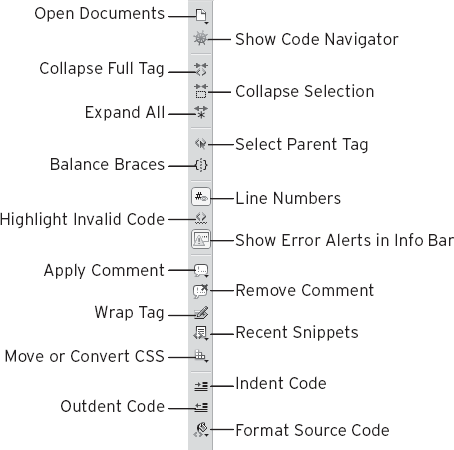
Figure 2-17. The Coding toolbar hugs the left edge of Code view, easily accessible to the power coder.
The following group of buttons helps coders verify proper code. Select Parent Tag quickly highlights the tag surrounding the current selection, and Balance Braces selects code within the matching set of parentheses, braces, or square brackets. Both Line Numbers and Highlight Invalid Code can also be found in the Visual Aids menu option of the Document toolbar.
Warning
Dreamweaver reads your code as you write it or make any changes in Code view. If any errors are found in the syntax of your code, a yellow info bar appears at the top of the document with the line number of a possible problem in your code if the Show Error Alerts In Info Bar option is enabled. If you're making a number of changes, you might want to disable this option to prevent being alerted to a series of false positives.
Comments are an essential building block of any programming language and Dreamweaver supports a wide range of them. Under the Apply Comments button, you'll find the option to insert HTML, JavaScript, CSS comments, and more. The different types of comments available are:
<!-- HTML Comments -->// CSS or JavaScript single line style comments/* CSS or JavaScript block style comments */'Visual Basic single line style commentsASP, ASP.NET, JSP, PHP, or ColdFusion style comments, depending on the application server used
Each of the comment options wraps a selection in the chosen comment style; in the case of single line style comments, the comments are placed at the start of each selected line. If no code is highlighted, an empty comment of the desired type is inserted.
Paired with the Apply Comment button is another option for deleting them, Remove Comment. The Remove Comment feature uncomments any selected code and will remove multiple comments unless they are nested. In the case of nested comments, only the outer comments are deleted.
Need a quick way to add a parent tag to a selection? Choose Wrap Tag and you can easily enter the desired outer element, along with any desired attributes and values. Press Enter (Return) to confirm your choices and the parent tag code is inserted.
You can wrap content with much more than a single tag through the Recent Snippets button. The Recent Snippets feature lists the 10 most recently used snippets, which can be either wrap or block type.
The next button, Move or Convert CSS, includes two CSS management functions: Convert Inline CSS to Rule and Move CSS Rules. The Convert Inline CSS to Rule extracts styles that are defined within a selected tag (or inline), like this:
<div id="pullQuote" style="float: right; margin: 5px;">
to a new rule, like this:
pullQuote {
float: right;
margin: 5px;
}You'll have an opportunity to choose whether the new rule should be saved in the <head> section of the current document or in an external style sheet. Inline styles are somewhat harder to manage and more limited in their effect and, under most circumstances, should be converted to rules.
The clearly named Move CSS Rules does just that: moves selected CSS rules from the current page or style sheet to an external style sheet. You can specify an existing style sheet or create a new one to hold your rules. This command is especially beneficial for designers who — like me — prefer to embed CSS rules when first creating a new layout.
The final buttons on the Coding toolbar are used for styling your code. The Indent Code and Outdent Code buttons move selected code blocks in or out according to the options set in the Code Format category of Preferences. The final button, Format Source Code, allows you to style either the entire document or a selection of your code according to the Code Format Settings — which, along with another code style option, Tag Libraries — is also available under this menu.
Dreamweaver's Live View is, at its heart, a full-fledged Web browser. And, like other Web browsers, Live View can be used to jump from one page to another via links or by direct URL input. You can control how you move through a site — and the code displayed — through the Browser Navigation toolbar.
Note
Much of the Browser Navigation toolbar functionality is given over to mimicking a traditional browser. There are back and forward buttons, an easy way to refresh the page, an address field for quick URL entry, and even a home icon to get you back where you started. More Dreamweaver-specific commands that, for example, allow you to freeze JavaScript and reveal generated code, are handily grouped under a menu button. The key elements of the Browser Navigation toolbar are:
Back and Forward: Browser-like buttons for moving to and from a previously selected Web page.
Refresh: Reloads the current page.
Home: Displays the initially loaded page in Live View.
Address: Shows current page URL and can be used to enter a new Web address.
Live View options: Contains a collection of commands related to Live View.
Once Live View is engaged, the icons on the Browser Navigation toolbar become active and the current page's file URL is shown in the Address field, like file:///C|/inetpub/wwwroot/Ellen%20Celli%20Jewelry/index.htm or, on the Mac, file:///Macintosh%20HD/Users/josephlowery/Sites/markofthejoe/index.htm. Amazingly, you can enter any standard URL in the Address field, press Enter (Return) and, assuming you're online, display that Web page in Dreamweaver. Moreover, if you click Live Code, you can even see how it's built, as shown in Figure 2-18.

Figure 2-18. Open pages from the Web, complete with source code, with the Browser Navigation toolbar.
The Live View Options menu offers a variety of commands, all geared toward helping you make the most of Live View:
Freeze JavaScript: Stops JavaScript from functioning so you can inspect the current state in Live Code.
Disable JavaScript: Turns JavaScript off, as a user might, to display the page under that condition.
Disable Plugins: Turns any plugin, such as the Flash Player, off so you can test your page output is that scenario.
Highlight Changes in Live Code: Adds a background color to source code during user interactivity.
Edit the Live View page in a new tab: Opens the current page, navigated to in Live View, in a new Document Window.
Follow Link (Ctrl+Click/Cmd+Click Link): Displays linked pages in Live View when the listed keys are pressed and the link clicked.
Follow Links Continuously: Displays related pages when the link is clicked without requiring a modifier key.
Automatically Sync Remote File: Includes related files that are hosted remotely automatically.
Use Testing Server for Document Source: Pulls the linked pages from the designated testing server in the Site dialog box.
Use Local Files for Document Links: Relies on files saved locally to displayed linked pages.
HTTP Request Settings: Opens a dialog for setting URL and form parameters.
Note
For more details on using the Live View options, see Chapter 5. HTTP Request Settings are covered in Chapter 21.
The Insert panel holds the items most frequently used — the primary colors, as it were — when designing Web pages. You can select everything from images to ActiveX plugins to HTML comments from the Insert panel. Figure 2-19 illustrates the Insert panel.
The Insert panel is divided into separate categories of objects: Common, Layout, Forms, Data, Spry, InContext Editing, Text, and Favorites. Additional advanced categories are available for various server-side scripting languages: ASP, CFML Basic, CFML Flow, CFML Advanced, PHP, and XSLT. These advanced categories are available only when the currently open document is of the relevant file type, as determined by its file extension. Table 2-2 shows the file extensions related to each category.
Table 2-2. File Types for Advanced Categories
Insert Panel Category | Related File Extensions |
|---|---|
ASP |
|
CFML Basic |
|
CFML Flow |
|
CFML Advanced |
|
PHP |
|
XSLT |
|
The initial view is of the Common category. Switch from one category to another by selecting the appropriate choice from the category menu (see Figure 2-20).
Tip
If you yearn for the good old days pre-CS4, when the Insert panel was an Insert bar, fear not. From the Workspace switcher, choose Classic to move the Insert panel to its former position above the Document window. Once the change is made, if you prefer the Insert panel tab view rather than the menu view, choose Show As Tabs from the bottom of the category menu. To switch back, right-click and choose Show As Menu, as shown in Figure 2-20.
Figure 2-20. You can switch your Insert panel view from menus to tabs and back again when in the Classic workspace.
If the Insert panel is not available when you first start Dreamweaver, you can enable it by choosing Window
Tip
The icons in Dreamweaver's Insert panel are intentionally grayscale in appearance to keep focus on the Web page under development. When you hover over them with your cursor, they change to a colored icon. If you'd prefer to have the icons always appear in color, right-click (Control+click) and choose Colored Icons from the pop-up menu.
The following sections describe each category in the Insert panel.
The most frequently used HTML elements, aside from text, are accessible through the Common category of the Insert panel.
The Insert panel in Dreamweaver uses menu buttons in each category, like the Images and Media menus in the Common category. Menu buttons are identifiable by a small downward-pointing arrow to the right of the button. Numerous objects are contained within each menu group; when you choose an object, that object becomes the default item for the menu. For example, if you choose Image Placeholder from the Images menu group, the icon for that menu item is displayed in the Insert panel. Image Placeholder then becomes the default until another item from the group, such as Image or Fireworks HTML, is chosen. The first time any menu button is accessed, no default object yet exists, and you must choose an object from the menu group.
The Common category contains five submenus: Images, Media, Head, Script, and Templates. Everything from basic images to the navigation bar is available from the Images group, as shown in Figure 2-21. Dreamweaver facilitates the inclusion of external elements — such as multimedia animations, Java applets, plugins, and ActiveX controls — through the Media group of the Insert panel's Common category. Under the Head menu button, you'll find tags that affect or describe the entire document, such as keywords and description, and that are inserted in the <head> area of the page. The Script group contains only two objects — Script and No Script — that give the designer the option of including JavaScript external files or functions or telling the browser what to display if the user does not have JavaScript enabled. Templates are special Dreamweaver documents that define the layout and visual design of a page. The most common template options are found under the Template menu on the Insert panel's Common category.
Many of the common objects open a dialog box that enables you to browse for a file or specify parameters. If you prefer to enter all your information (including the necessary filenames) through the Property inspector or in Code view, you can turn off the automatic appearance of the dialog box for some objects when inserted through the Insert panel or the menus. Choose Edit
Note
Additional Preferences settings, located in the Accessibility category of the Preferences dialog box, also cause dialog boxes to appear when you insert an object using the Insert panel. These accessibility dialog boxes appear even if the Show Dialog When Inserting Objects option is clear.
General document information — such as the title and any descriptive keywords about the page — are written into the <head> section of an HTML document. The Head menu objects enable Web designers to drop in these bits of code in a handy object format. Although Dreamweaver enables you to see the <head> objects onscreen via the View
Script menu objects simplify the task of adding custom scripts or server-side includes to your page.
You use the Layout category of the Insert panel to work with tables, <div> tags, AP elements, and frames — objects that enable you to define the layout of your page. You can even insert advanced JavaScript-controlled elements through the four Spry widgets available here: the Spry Menu Bar, Spry Tabbed Panels, Spry Accordion, and the Spry Collapsible Panel. These objects are explained a bit later in this chapter in the section covering the Spry category, Spry Objects.
Dreamweaver offers you two ways to work with tables. You can use Standard mode (where you define the structure of a table using dialog boxes, menu commands, and the Property inspector), or you can use Expanded Table mode (where the table structure is made more obvious for easy modification). Switch between these mutually exclusive modes by clicking their buttons in the Layout category.
You'll also find objects for manipulating table structure, such as those for adding a row or column, as shown in Figure 2-22, as well as a button for inserting an <iframe> tag. The final button in the category, the Frames menu button, lists a full range of frame layouts.
Note
Because of the visual nature of tables and AP elements, many of the objects in the Layout category can be used only in Design view.
Forms are the primary method for implementing HTML interactivity. The Forms category of the Insert panel gives you the basic building blocks for creating your Web-based form — including the Form tag, Text field, Checkbox, and Radio buttons — as shown in Figure 2-23.
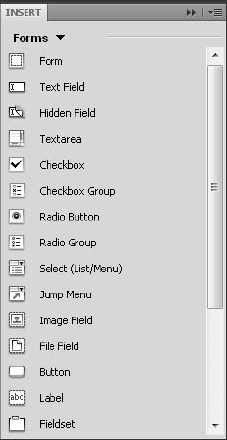
Figure 2-23. Implementing forms is a key aspect of Web applications; not shown are the various Spry Validation form objects.
As with the Layout category, the Forms category has several JavaScript-driven objects. These Spry-based elements provide form validation as well as the basic form object. For more details, see the section "Spry Objects" later in this chapter.
Although the layout of a Web page and the dynamic content that fills it may vary widely, much of the code underlying basic Web data operations remains the same. For example, the basic code that is used to insert employee records into a Human Resources database may also be used to add a new entry into a database that maintains a DVD collection. Dreamweaver removes much of the tedium of scripting common Web applications by supplying objects in the Data category of the Insert panel. Additionally, you'll also find objects for handling data in non-dynamic formats, including importing tabular data and applying Spry data sets. For more information about the Spry elements, see the following section.
With a single Data object, you can build an entire Web application that displays a list of records, enables you to navigate through them, displays which records are currently onscreen, and links to another page with detailed information from a selected record. In general, Dreamweaver's Data objects can be used separately or together. The Master Detail Page Set object includes two other Data objects: the Recordset Navigation Bar object and the Recordset Navigation Status object.
Data objects, shown in Figure 2-24, are particularly powerful when combined with Dreamweaver's template feature. It's possible, for example, to create a basic Master Detail Page Set with the Data object and then apply a template to give the page a specific look and feel, thereby integrating it into a site. Numerous menu buttons bring almost all of Dreamweaver's server-side power to the Insert panel.
Spry is an Ajax (Asynchronous JavaScript and XML) framework developed by Adobe. The Spry objects in Dreamweaver make it easy to apply the more powerful facets of Ajax, including the capability to update data in a portion of the page without refreshing the entire page.
The Spry category of the Insert panel, shown in Figure 2-25, is divided into three groups: data, forms, and layout. As noted earlier, these objects are also available from each of the Insert panel's corresponding categories. The Dreamweaver team decided to take this multiple access approach to both highlight the new Spry technologies and emphasize where the various components fit in the Web designer's workflow.
Note
You'll find a full chapter devoted to the world of Ajax and the Spry implementation in Chapter 16.
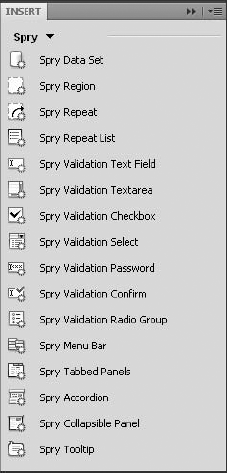
Figure 2-25. Spry objects make it possible to include advanced JavaScript and XML technologies with the click of a mouse.
The Spry data objects work with associated HTML or XML files to selectively display just the data requested by the user. The first object in the group, Spry Data Set, is a wizard that establishes the connection to the data and, optionally, lays out the elements. The other objects are components of this process and can be applied separately. Table 2-3 details the individual Spry data objects.
Table 2-3. Spry Data Objects
Icon | Name | Description |
|---|---|---|
Spry Data Set | Identifies an HTML or XML data source and data columns to work with. | |
Spry Region | Sets an HTML tag, typically | |
Spry Repeat | Establishes a repeating region for Spry data within | |
Spry Repeat List | Repeats Spry data for list-related tags, such as |
The Spry form objects add client-side validation to a range of form elements. With validation enabled, users are immediately informed if they enter their information in the wrong format. Table 2-4 lists the available Spry form objects.
Table 2-4. Spry Form Objects
Icon | Name | Description |
|---|---|---|
Spry Validation Text Field | Inserts a standard text field with 13 different validation types. | |
Spry Validation Textarea | Inserts a textarea form element that can be required or restricted to a certain number of characters. | |
Spry Validation Checkbox | Includes a checkbox form element to the page that can be required or, if multiple checkboxes are used, restricted to a minimum or maximum selected. | |
Spry Validation Select | Adds a menu select list to the page that checks to see if a choice or invalid selection has been made. | |
Spry Validation Password | Inserts a password field with masked input, which can require a defined number of letters, numbers, uppercase letters, and special characters. | |
Spry Validation Confirm | Adds a password or text field where the input value is required to match the input value of another such field on the form. | |
Spry Validation Radio Group | Includes two or more radio buttons, which can be required. |
The four Spry layout objects bring enhanced layout possibilities to every designer's palette. Each of the Spry layout options — from the Menu Bar to the Accordion panel — are easily customizable in Design view with the help of the dedicated Property inspectors. Table 2-5 provides details about the Spry layout objects.
Table 2-5. Spry Layout Objects
Name | Description | |
|---|---|---|
Spry Menu Bar | Inserts a standards-based vertical or horizontal navigation bar, capable of supporting multiple levels. | |
Spry Tabbed Panels | Adds a series of content areas to the page, each made visible by selecting the corresponding tab. | |
Spry Accordion | Initially includes two sliding content areas, which can be opened and closed interactively by the page visitor; additional areas can easily be added. | |
Spry Collapsible Panel | Inserts a pod-like region that can be expanded or collapsed with a mouse click. Multiple panels, independently controlled, can be applied to a page. | |
Spry Tooltip | Adds a completely customizable tooltip to any page selection, which can be configured with various effects, such as fade and blind. |
InContext Editing is a commercial service from Adobe that allows anyone to make updates to specific areas of their Web pages directly through the browser, without installing any additional software. InContext Editing is perfect for those clients who want control of their content, but lack the technical expertise to create and modify the pages in a Web authoring tool like Dreamweaver. The InContext Editing editable areas are inserted and managed through the objects found in the Insert panel InContext Editing category, shown in Figure 2-26. In addition to an object for creating an editable region, this category also includes another for generating a repeating region.
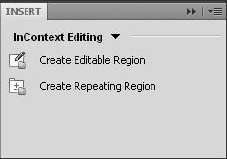
Figure 2-26. InContext Editing objects make it possible to modify Web pages directly in the browser.
Note
InContext Editing is covered in depth in Chapter 28.
The text objects represent the most commonly used text formatting HTML tags, such as those needed to emphasize text, change the font face, or create bulleted lists (see Figure 2-27).
The Text objects behave differently, depending on whether you are working in Design view or Code view. If you are working in Code view, Dreamweaver puts you in charge and simply surrounds whatever text is selected with the appropriate HTML tags. If no text is selected, the tag pair is inserted at the current text insertion point.
In Design view, Dreamweaver also surrounds selected text with the appropriate tag pair. But in some situations, Dreamweaver does more than blindly surround the selected text with the specified HTML tags. The following examples illustrate the additional processing that occurs in Design view:
In Design view, the Paragraph, Preformatted Text, Heading 1, Heading 2, and Heading 3 objects are treated as mutually exclusive. If you select text that is formatted as a Heading 1, and then you click the Heading 2 button on the Insert panel, Dreamweaver not only surrounds the selected text with
<h2></h2>tags, but also removes the<h1></h1>tags that were there before. In Code view, Dreamweaver simply adds the<h2></h2>tags without automatically removing the<h1></h1>tags. This is inappropriate coding and should be avoided.When you select one or more paragraphs of text in Design view and then click the Unordered List button, Dreamweaver creates a bulleted list by inserting
<ul></ul>tags around the selected text, as in Code view. But in Design view, Dreamweaver additionally converts each paragraph to a separate item in that list by inserting the appropriate<li></li>tags. The same is true for Ordered lists and Definition lists.
In Design view, if no text is selected when you click one of the text formatting buttons in this category, no tags are added until you start typing. This feature helps prevent the inclusion of empty tag pairs within your document.
The Text category contains a single menu button: Characters. Certain special characters — such as the copyright symbol (©) — are represented in HTML by codes called character entities. Dreamweaver eases the entry of these complex, hard-to-remember codes with the Characters objects. The most commonly used characters are included as separate objects, and another button opens a dialog box with additional special characters from which to choose. The Characters category also contains objects for inserting a line break and a nonbreaking space.
Because you can choose from an overwhelming number of objects on the Insert panel, the Favorites category is a welcome and productive addition to Dreamweaver. Initially, no objects are displayed in the Favorites category — it's up to you to choose which objects to include. All modification of the Favorites category is handled through the Customize Favorite Objects dialog box (see Figure 2-28), which shows all the available objects on the left and the selected objects on the right. Objects can be grouped through use of a dotted-line separator.
To add, remove, or modify objects in the Favorites category, follow these steps:
Choose Favorites from the Insert panel menu or tab.
Right-click (Control+click) and choose Customize Favorites from the context menu. You can actually perform the same action from any category/tab of the Insert panel to open the Customize Favorite Objects dialog box.
In the Customize Favorite Objects dialog, select the category holding the object you want to display in the Favorites category from the drop-down list under Available Objects. The All category displays every available object, sorted by category. If you know what category your object is in, it's quicker to select that category from the list.
Choose an object from those listed in the Available Objects area and select the double-arrow button. The selected item moves to the Favorite Objects list.
Repeat Steps 3 and 4 to declare additional objects as favorites.
Change the order in which the objects are displayed by selecting an object and then clicking Up or Down to move the object left or right, respectively.
To delete an object from the Favorites list, select it and choose Remove.
To group objects together, choose Add Separator to insert a dotted-line divider.
When you're finished, click OK.
The objects you've selected, in the order you've specified, appear in the Favorites category. You can modify these objects at any time by re-opening the Customize Favorite Objects dialog.
If you are creating Active Server Pages, the ASP category of the Insert panel can speed up the development of your code. Only available when the current document is named with an extension of .asp, this category contains the building blocks of an ASP page.
The CFML category of the Insert panel gives you access to the most frequently used objects in the ColdFusion toolbox. This category is available on the Insert panel only if the active document has a file extension of .cfm or .cfc. The first is Flow, which inserts ColdFusion markup tags that alter the flow of control through the code. The second is Advanced, which provides numerous advanced functions, such as those that enable you to transfer files and data using a variety of protocols.
Tip
You can find detailed descriptions of the ColdFusion tags in the Reference panel. To view the ColdFusion documentation, select Window
Dreamweaver's Property inspector is your primary tool for specifying an object's particulars. What exactly those particulars are — in HTML, they are known as attributes and in CSS, properties — depends on the object itself. The contents of the Property inspector vary depending on which object is selected and which button, HTML or CSS, is selected. For example, click anywhere on a blank Web page, and the Property inspector set to HTML shows text attributes for format, bold, italic, and so on. When in CSS mode, the same selection displays the targeted rule, font name, size, color, and so on. If, however, you click an image, the Property inspector displays a small thumbnail of the picture, and the image's attributes for height and width, image source, link, and alternative text (see Figure 2-29). There is no HTML or CSS option.

Figure 2-29. The Property inspector takes many forms, depending on the HTML element you select and, if text, whether you're in HTML or CSS mode.
You can enable the Property inspector by choosing Window
Warning
For text — whether in a paragraph, heading, or table cell — the Property inspector can switch between two modes: HTML and CSS. You move from one mode to the other by clicking the HTML or CSS button on the far left of the Property inspector. When in HTML mode, you can choose a standard text format, such as paragraph or any of the heading tags, set a class or ID, provide a link, add a <strong> or <em> tag through the Bold and Italic buttons, or change to an ordered or unordered list. Enter CSS mode to redefine text-based properties of applied rules, such as font-family, color, font-size, font-weight, font-style, and text-align. The CSS mode is also an efficient way to initially define a new style for a selection.
Note
For more information about applying the HTML attributes and CSS properties to text, see Chapter 7.
You can reposition the Property inspector in one of the following ways:
If the Property inspector is floating, you can click and drag the drag bar that appears along the left edge of the window and move it to a new location.
You can also click and drag any open gray area in the floating inspector itself, a difference between it and the Insert panel. This technique is handy for quickly moving the inspector aside, out of your way.
When you move the floating inspector near the edge of the screen or near a window border, the Property inspector snaps to the edge of the window or screen.
The Property inspector initially displays the most typical attributes for a given element. To see additional properties, click the expander arrow in the lower-right corner of the Property inspector. Virtually all the inserted objects have additional parameters that can be modified. Unless you're tight on screen real estate, it's a good idea to keep the Property inspector expanded so you can see all your options.
Tip
In addition to using the expander arrow, you can reveal (or hide) the expanded attributes by double-clicking any open gray area of the Property inspector.
Many of the attributes in the Property inspector are text boxes; just click in any one and enter a value. If a value already appears in the text box, whether a number or a name, double-click it (or click and drag over it) to highlight the information and then enter your new data — the old value is immediately replaced. You can see the effect of your modification by pressing the Tab key to move to the next attribute or by clicking in the Document window.
Using the Quick Tag Editor, you can make small additions to the code without switching to Code view. Located on the right of the Property inspector, just below the Help button, the Quick Tag Editor pops open a small window to display the code for the currently selected tag. You can swiftly change attributes or add special parameters not found in the Property inspector.
For several attributes, the Property inspector also provides drop-down list boxes that offer a limited number of options. To open the drop-down list of available options, click the arrow button to the right of the list box. Then choose an option by highlighting it.
Tip
Some options on the Property inspector are a combination drop-down list and text box — you can select from available options or type in your own values. For example, when text is selected, the font name and size are combination list/text boxes.
If you see a folder icon next to a text box, you have the option of browsing for a filename on your local or networked drive or manually inputting a filename. Clicking the folder opens a standard Open File dialog box (called Select File in Dreamweaver); after you've chosen your file and clicked OK (Open or Choose on the Mac), Dreamweaver inputs the filename and any necessary path information in the correct attribute.
Dreamweaver enables you to quickly select an onscreen file (in either a Document window or the Files panel) as a link, with its Point to File icon, found next to the folder icon. Just click and drag the Point to File icon until it touches the file (or the filename from the Files panel) that you want to reference. The path is automatically written into the Link text box.
Certain objects such as text, AP elements, and tables enable you to specify a color attribute. The Property inspector alerts you to these options with a small color box next to the text box. You can type in a color's name (such as blue) or its three- or six-figure hexadecimal value (such as #3366FF or #666), or select the color box. Choosing the color box opens a color picker, shown in Figure 2-30, that displays the colors common to both the Netscape and Microsoft browsers — the so-called browser-safe colors. You can go outside of this range by clicking the System Color Picker icon in the upper-right corner of the color picker. Selecting this icon opens a full-range Color dialog box in which you can choose a color visually or enter its red, green, and blue values or its hue, saturation, and luminance values.

Figure 2-30. Dreamweaver's color picker enables you to choose from a wide selection of colors, from the palette or right off the desktop, with the Eyedropper tool.
The color picker in Dreamweaver is very flexible. Not only can you choose from a series of color swatches, but you can also select any color onscreen with Dreamweaver's Eyedropper tool. If you'd like to access the system color picker, the color wheel button opens it for you. You can also use the Default Color tool, which deletes any color choice previously inserted. Finally, you can use the color picker's context menu to change the swatch set shown. By default, the Color Cubes view is shown, but you can also view swatches in a Continuous Tone configuration or in Windows OS, Mac OS, or Grayscale colors. Although the Web designer may not use these options frequently, Adobe standardized the color picker across its product line to make it easier to switch between applications.
Tip
To close the color picker without selecting a color, click in the empty gray area at the top of the color picker.
The Property inspector also includes a panel menu. Open this context-sensitive menu by clicking the panel menu icon, located in the upper-right corner of the Property inspector. The commands on this menu vary depending on what type of object has been selected in the Document window. Some basic commands, however, are always available, regardless of what has been selected, such as the following:
Help: Opens a Help topic for the current Property inspector
Rename Panel Group: Enables you to rename the Property inspector
Close Panel Group: Closes the Property inspector
Note
Two additional commands that are typically available for panels, Group Properties With and Maximize Panel Group, are disabled for the Property inspector. You cannot dock the Property inspector with other panels, and you cannot change the height of the Property inspector.
Also note that the circled question mark in the upper-right corner of the Property inspector is the Help button. Clicking this button invokes online Help and displays specific information about the particular Property inspector you're using.
Dreamweaver is known for its powerful set of tools: behaviors, AP elements, and so much more. Dreamweaver presents its tools in a variety of panels, as shown in Figure 2-31. Panels can be combined into the same window; when grouped together in this way, each panel is displayed as a tab within the panel group. The panel groups can be floating, docked to each other, or docked within the Dreamweaver window.

Figure 2-31. Dreamweaver's many tools reside in panels, which can float anywhere on the screen or be docked within the Document window.
Table 2-6 lists each of the panels available in Dreamweaver, along with a description and a cross-reference to chapters in this book that provide more information about the panel. It also lists a keyboard shortcut that you can use to open the panel. If the keyboard shortcut is different between Mac and Windows platforms, the Mac shortcut is listed in parentheses after the Windows shortcut. If the Mac shortcut is not available, the initials N/A are displayed in the parentheses.
Table 2-6. Dreamweaver Panels
Keyboard Shortcut | Description | Detailed Information | |
|---|---|---|---|
CSS Styles | Shift+F11 (N/A) | Enables you to create external and embedded CSS style sheets. | See Chapter 6. |
AP Elements | F2 | Enables you to view and change some characteristics of AP elements. | See Chapter 10. |
Business Catalyst | Ctrl+Shift+B (Command+Shift+B) | Connects you to the Business Catalyst service. | See "Connecting to Adobe Services" in this chapter. |
Databases | Ctrl+Shift+F10 (Command+Shift+F10) | Provides a bird's-eye view of all the connections currently defined for your site, enabling you to add new connections; browse tables, views, and stored procedures for each database; and add the necessary server-side include to use that connection. | See chapters in Part IV. |
Bindings | Ctrl+F10 (Command+F10) | Enables you to create recordsets and datasets and display that information on your page. You can also bind data to tag attributes and form elements and set the formatting for dynamic elements. | See chapters in Part IV. |
Server Behaviors | Ctrl+F9 (Command+F9) | Gives you access to prewritten server-side scripts that are used in applications. For example, you can use server behaviors to create, update, or delete records. | See Chapter 34. |
Components | Ctrl+F7 (Command+F7) | Enables you to quickly add new ColdFusion components. | See Chapter 19. |
Files | F8 (Command+Shift+F) | Manages the files in your local, remote, and testing sites. | See Chapter 4. |
Assets | None | Gives you access to many components that make up your site, including images, colors, URLs, Flash and Shockwave objects, movies, scripts, templates, and library items. | See the following: Images: Chapter 8 Colors: Chapter 7 URLs: Chapter 9 Flash: Chapter 25 Shockwave: Chapter 25 Movies: Chapter 26 Scripts: Chapter 5 Templates: Chapter 28 Library: Chapter 29. |
Snippets | Shift+F9 (N/A) | Gives you access to prewritten snippets of code for common scenarios. | See Chapter 5. |
Tag Inspector | F9 (Option+Shift+F9) | Displays a collapsible outline of the tags used on the current page, enabling you to quickly determine if tags are correctly nested, and to view and change tag attributes. | See Chapter 5. |
Behaviors | Shift+F4 | Enables you to create Dynamic HTML effects. | See Chapter 11. |
History | Shift+F10 (N/A) | Tracks each change you make, enabling you to undo and redo multiple steps at a time. | See Chapter 7. |
Frames | Shift+F2 | Enables you to select and rename frames within a frameset. | See Chapter 15. |
Code Inspector | F10 (Option+F10) | Provides an alternative to Code view in a floating window. | See Chapter 5. |
Results | F7 to open the Results panel and then choose the Search category | Shows the results of a Find All request. | See Chapter 7. |
Results | F7 to open the Results panel and then choose the Reference category | Presents extensive reference documentation for HTML, CSS, JavaScript, accessibility guidelines, and a variety of server-side scripting languages. | See Chapter 5. |
Results | F7 to open the Results panel and then choose the Validation category | When you validate a document, the results are displayed in this panel. | See Chapter 30. |
Results | F7 to open the Results panel and then choose the Browser Compatibility category | Displays results of a Browser Compatibility check. | See Chapter 30. |
Results | F7 to open the Results panel and then choose the Link Checker category | Shows the results when you check for broken links within your site. | See Chapter 9. |
Results | F7 to open the Results panel and then choose the Site Reports category | Displays the output from a variety of site reports. | See Chapter 31. |
Results | F7 to open the Results panel and then choose the FTP Log category | Lists the results of FTP operations. | See Chapter 4. |
Results | F7 to open the Results panel and then choose the Server Debug category | Enables you to browse your page directly in Dreamweaver's Design window as if it were a Web browser. This is different from Live Data view because the page is not editable. | See Chapter 34. |
Extensions | None | Connects to the service for previewing current page in a variety of Web browsers and operating systems. | See "Connecting to Adobe Services" in this chapter. |
Extensions | None | Displays the Creative Suite News and Resources Web site. | See "Connecting to Adobe Services" in this chapter. |
Extensions | None | Connects to the Creative Suite Live services on | See "Connecting to Adobe Services" in this chapter. |
Extensions | None | Connects to the Adobe screen-sharing service ConnectNow. | See "Connecting to Adobe Services" in this chapter. |
Because of the large number of panels available in Dreamweaver, your workspace can become cluttered very quickly. To reduce the amount of screen real estate taken up by the individual panels but still utilize their power, Dreamweaver enables you to group multiple panels in a single window. These groups of related panels are called, not surprisingly, panel groups. Whenever one panel is docked with another in a panel group, each panel becomes accessible by clicking its representative tab. Selecting the tab brings the panel to the front.
You can also display individual panels by using the keyboard shortcuts listed in Table 2-6, or by using commands in the Window menu; a separate command opens each panel. Using any of these methods opens the panel or brings it to the top if it is hidden; if the panel is already on top, any of these actions collapses the panel group so that only its title bar is showing.
Tip
One very important keyboard shortcut to remember is the F4 key, which hides all panels. This shortcut immediately clears the screen of all panels, including the Property inspector. Pressing F4 again restores all the hidden interfaces.
To maximize your Document window, you can reduce panels to an icon representation when closed. Simply make the panel smaller by dragging a panel's left or right edge; if the panel or panel group is docked, you'll need to drag the edge furthest from the program border. Once iconified, a click on the icon opens up the panel fully.
A panel can be set to remain open or automatically close once you click outside of it. To expose your options, right-click the Expand/Collapse icon (the double-triangle at the top of the panel or panel group in the dark gray border). From the pop-up menu, choose Auto-collapse Iconic Panels to automatically close your panel; leave this option unchecked to keep the panel open.
The panel groups may be docked along the edges of the Dreamweaver window. In this situation, you can collapse all the panel groups to maximize your work area by clicking the double-triangle button that appears at the top of the panel, as shown in Figure 2-32. This action collapses only the panel groups docked on one edge of the screen, leaving intact toolbars, floating panels, or even panels docked along a different edge of the window.
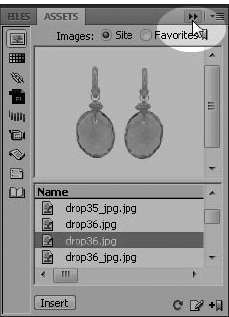
Figure 2-32. You can collapse all the panel groups along one edge of the screen with the click of a single button.
In any workspace, you can collapse an individual panel group so that just its title bar is showing. To do this, click the panel group name in the title bar, or click the small triangle next to the panel group name. To resize any floating panel, click and drag its borders. If the panel groups are docked together, you can drag the border of the panel area to resize all the panel groups in that area.
Finally, if you want to close a panel group entirely so that even its title bar is not visible, click the panel menu located on the right of the title bar in an open panel group, and then select Close Panel Group from the drop-down list. You can also right-click (Control+click) in the title bar and select Close Panel Group, even if the panel group is collapsed. The next time you open any panel within the group, the entire panel group opens automatically.
Note
The panel menu also gives you access to Help for the currently displayed panel, and may contain additional commands specific to the panel that is open.
Dreamweaver comes with related panels already combined into panel groups. However, you're not limited to the predefined panel groups. In fact, the panel groups are completely customizable, giving you optimum control over your workflow. Moving panels from one group to another, creating new groups, and renaming panel groups are straightforward operations. If you want, you can also remove little-used panels from groups and reorder the panels within a group.
To move a panel from one group to another, drag the panel's top border and drop it into place, Dreamweaver displays a blue border to indicate where the panel will be positioned. If the blue border appears as a thin line below existing docked panels, the moved panel will appear in its own panel group. If the blue border is displayed on a panel group's separator, the panel will be incorporated into that group. Finally, if the blue border appears to one side of the panel group, the panel will be docked to the side of the group. Why might you want to have two or more docked sets of panels? Dreamweaver (and all Creative Suite applications) allows only one panel in a docked panel group to be visible at one time. If you ever need to display two panels simultaneously, you can either establish them as individual panels or dock them in different panel groups.
Tip
To reorder panels within a panel group, or to drag panels into new panel groups, simply drag them by their tabs into new positions.
How do you remove a panel from a panel group? Simply drag it away. You can move a panel group by dragging the gray area next to any panel's tab (see Figure 2-33) and dragging the group to any location on the screen.
Like many programs, Dreamweaver's menus duplicate most of the features accessible through panels. Certain features, however, are available only through the menus in the Document window or through a corresponding keyboard shortcut. This section offers a reference guide to the menus when you need a particular feature or command. (Note to Windows users: The menus referred to here are those for the Document window and not the Files panel; the menu options particular to the Files panel are covered in Chapter 4.)
Tip
Almost every element placed in the Document window has a shortcut menu associated with it. To access a shortcut menu, right-click (Control+click) any area or object. The shortcut menus are context-sensitive and vary according to which object or area is selected. Using the shortcut menus can enhance your productivity tremendously.
Following is a glance at the various Dreamweaver Document window menus. You can find explanations of each command (along with its keyboard shortcuts for Windows and Mac) on this book's Web site.
File menu: Contains commands for file handling and overall site management. All import, export, and convert features are also found in this menu.
Edit menu: Provides the commands necessary to quickly modify your page — or recover from a devastating accident. Many of the commands (Cut, Copy, and Paste, for example) are standard in other programs; others, such as Paste HTML, are unique to Dreamweaver.
View menu: As you build your Web pages, you may find that it's helpful to be able to turn certain features on and off. The View menu centralizes all these commands and switches between Design view and Code view. One of the handiest commands hides all the visual aids with a keyboard shortcut, Ctrl+Shift+I (Command+Shift+I).
Insert menu: Contains the same items available through the Insert panel. In fact, if you add additional objects, you can see your objects listed on the Insert menu the next time you start Dreamweaver. All objects selected from the Insert menu are added to the page at the current cursor position.
Modify menu: Inserting objects is less than half the battle of creating a Web page. Most Web designers spend most of their time adjusting, experimenting with, and tweaking the various elements. The Modify menu lists all Dreamweaver's commands for altering existing selections.
Format menu: The Internet was initially an all-text medium, and despite all the multimedia development, the World Wide Web hasn't traveled far from those beginnings. The Format menu commands cover overall formatting as well as text-oriented functions such as spell checking.
Commands menu: Commands are user-definable code capable of affecting almost any tag, attribute, or item on the current page — or even the current site. Commands increase your productivity by automating many of the mundane, repetitive tasks in Web page creation.
Dreamweaver comes with several handy commands, but they are truly just the tip of the iceberg. Commands are written in a combination of HTML and JavaScript and can be created and modified by any capable JavaScript programmer.
The first few items on the Commands menu enable you to create, add, and manage custom commands. The additional items represent standard commands that come with Dreamweaver. If you add custom commands to Dreamweaver, they also appear in this menu.
Site menu: Web designers spend a good portion of the day directly interacting with a Web server: putting up new files, getting old ones, and generally maintaining the site. To ease the workflow, Dreamweaver groups site-management commands in their own menu.
Window menu: Manages both program and user-opened windows. Through this menu you can open, close, arrange, bring to the front, or hide all the additional Dreamweaver screens.
Tip
The commands for Dreamweaver's various windows, panels, and inspectors are toggles. Select a command once to open the window; select it again to close it.
Adobe has been extending its software reach to the online world and now Dreamweaver is making the online service connection. A number of services are already online, with more on the way. Best of all, you can now access these services directly from within Dreamweaver. The key services are Business Catalyst, Adobe BrowserLab, ConnectNow, CS Live, and CS News and Reports.
Business Catalyst is a Web site hosting company recently acquired by Adobe that offers Web developers and store owners a one-stop shop for full-featured online businesses. When you sign up for a Business Catalyst account, you're still able to design your site exactly the way you want to, you just don't have to do any of the coding in order to add application functionality such as email auto-responders, search and result pages, and event registration — even a completely functioning online store. Business Catalyst makes it easy to track your site visitors, customers, and sales with built-in reporting tools.
Note
The Business Catalyst panel in Dreamweaver has two key functions: first, to inform you about the service and second, to help you install and use Triangle, an extension that helps you build and maintain your Business Catalyst site. After you've installed Triangle with the Adobe Extension Manager, the Business Catalyst panel displays the Triangle interface (see Figure 2-34). Triangle communicates directly with the host and replaces much of the typical Dreamweaver file management functionality. With Triangle, for example, you can load pages directly from the live site, make any desired changes and instantly publish them. Triangle also allows you to apply any templates or include any advanced server-side functionality with point-and-click ease. The Business Catalyst service is great for Web designers who need to create sites with server-side functionality that is beyond their level of technical expertise.
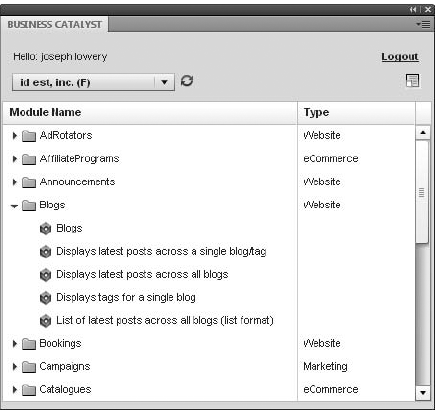
Figure 2-34. Once the Triangle extension has been installed, you can access your sites on the Business Catalyst site directly.
To learn more about this integrated Dreamweaver service and decide if it is for you, click the Learn More button in the Business Catalyst panel.
Adobe BrowserLab is a browser virtualization service. Similar services, such as Browser Cam, have been around for a number of years and are a great asset to Web designers who want to compare how their pages look in a number of browsers. BrowserLab, however, takes the practice a step further. Rather than use a real browser to display the picture and then take a screen grab — which can be very time intensive — BrowserLab is software-based and much quicker. With BrowserLab, you can view the same page from two different browsers on the same screen; you can even overlay one over the other with transparency, so you can quickly identify differences.
Note
To get started with BrowserLab, choose Window

Figure 2-35. Quickly compare the same page through two different browser configurations with BrowserLab.
As of this writing, BrowserLab supports a dozen different browser version and operating system (OS) combinations. BrowserLab allows you to create custom sets of browser/OS configurations so you can quickly preview the ones most important to you. BrowserLab was intended to supplement Live View and, through the use of the Freeze JavaScript Live View option, you can even use it to preview interactive states across a range of browsers.
If you've ever tried to describe a site-in-progress to a client, you'll greatly appreciate the Share My Screen feature in Dreamweaver. Choose File
You'll need an account on Adobe.com to log in to the ConnectNow service. Accounts are free and only require an e-mail address and password. Once you've logged in the first time, you'll be asked to download and install the Adobe ConnectNow add-in for full functionality; installation is automatic and very quick. Next, you'll be presented with a URL to send to clients with whom you want to share your screen in the format of
https://connectnow.acrobat.com/usernamewhere username is your Adobe log-in. You can either send this information through your own e-mail program or use the Invite Participants option in ConnectNow to start a new e-mail message prepopulated with subject and invitation, complete with meeting URL. The ConnectNow service is free for three or fewer participants (including the designer as the host).
Tip
If you find yourself logging in to Adobe services over and over again, choose Window
Once you and your client are in the ConnectNow online meeting, choose Share My Computer Screen to display your Dreamweaver or other screen. You'll have an option to chat, enter notes, or even annotate the screen with arrows, text, or highlighted regions, as shown in Figure 2-36. You can also incorporate a webcam and/or microphone, if you have them available.
Dreamweaver includes several additional services to help you make the most of your Adobe connection: CS Review, SiteCatalyst Net Averages, Adobe Story, Acrobat.com, and CS News and Resources as well as options to manage your Adobe services account and explore CS services. You can access all these options by clicking the CS Live button in the App bar or choosing Window
CS Review – An online service that makes it possible for Creative Suite 5 users to share designs for commenting and review.
SiteCatalyst NetAverages – Provides users access to metrics and benchmarks for their sites.
Adobe Story – A collaborative tool for developing professional screenplays.
Acrobat.com– Your one-stop shop for sharing large files, your screen or the online creation and modification of word-processing documents.CS News and Resources - Gives users an up-to-the-minute report on what's happening with the Creative Suite line of products via an RSS feed published by Adobe.
In this chapter, you were introduced to some of the power of Dreamweaver and had a look at its well-designed layout. From the Insert panel to the various customizable panels, Dreamweaver offers you an elegant, flexible workspace for creating next-generation Web sites. Here are some of the key points covered in this chapter:
Users can choose from eight default workspace layouts or choose to structure their workspace in whatever manner best suits their workflow. The same basic tools are available in each layout; the primary difference involves where the panels are located and whether you have more than one display.
The Document window is your main canvas for visually designing your Dreamweaver Web pages. This window includes simple, powerful tools such as the Tag Selector, Zoom, and the Window Size pop-up menu.
Frequently used tools are available on Dreamweaver's various toolbars. The toolbars can be displayed or hidden depending on your personal preferences.
The Insert panel is Dreamweaver's toolbox. Highly customizable, the Insert panel holds the elements you need most often, grouped into useful categories. You can customize one category of the Insert panel, Favorites, and place your own most commonly used objects together.
Dreamweaver's mechanism for assigning details and attributes to an HTML object is the Property inspector. The Property inspector is context-sensitive, and its options vary according to the object selected.
Many of Dreamweaver's tools reside in separate panels, which can be combined into panel groups. Panel groups can be docked or floated, hidden or shown, depending on your workflow.
Dreamweaver's full-featured menus offer complete file manipulation, a wide range of insertable objects, the tools to modify them, and extensive online — and on the Web — help. The most commonly used menu items can be invoked through keyboard shortcuts.
Services in Dreamweaver can help you build a complex site, connect you to a client, or let you preview your page in any number of browsers.
In the next chapter, you learn how to customize Dreamweaver to work the way you work by establishing your own preferences for the program and its interface.
